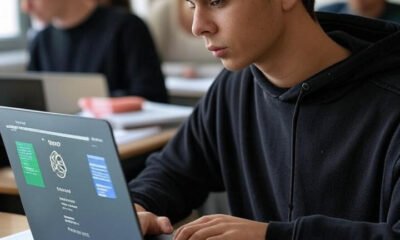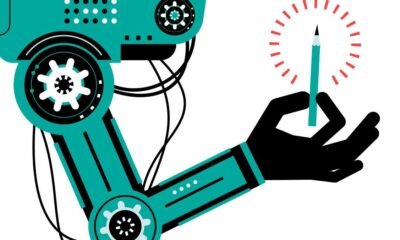Education
Education 5.0: AI and personalized learning drive the future of learning

The rapid rise of artificial intelligence (AI) and immersive digital tools is reshaping the foundations of modern education, demanding urgent strategic reform to prepare Generation Alpha for a technology-driven future.
Researchers have mapped this educational shift in a study titled “Education Strategy for the Net Generation”, published in Information. The paper calls for a complete overhaul of conventional teaching practices, outlining a new pedagogical model to align learning with the dynamic realities of the digital and generative AI eras.
The shift from digital to generative pedagogy
The research positions the evolution of education within a broad historical and technological framework, explaining how learning models must keep pace with societal and digital transformations. The authors describe how the transition from Web 2.0 to Web 4.0, combined with the rise of generative AI (GAI), large language models (LLMs), and immersive technologies like AR, VR, and IoT, has ushered education into a new era – Education 5.0.
Education 4.0, driven largely by digital pedagogy and the integration of online platforms, was sufficient for the early 21st century but no longer meets the needs of learners shaped by hyper-connectivity and intelligent systems. Generation Alpha, those born between 2010 and 2024, are fundamentally different from previous generations, acquiring information in complex, dynamic ways and demanding new teaching approaches that merge human intelligence with advanced technological tools. According to the authors, Education 5.0 is not just an incremental improvement; it represents a paradigm shift toward generative pedagogy, a hybrid system combining symbolic cognitive methods with AI-powered connectionist approaches.
This new framework emphasizes personalized learning paths, real-time feedback loops, and collaborative, interdisciplinary environments. Teachers, once positioned as transmitters of knowledge, must now act as mentors and interpreters, guiding students through the complexities of human–machine interaction. The model calls for cultivating not only cognitive skills but also emotional and ethical intelligence, ensuring that students remain critically aware and human-centered in a digital landscape increasingly mediated by AI.
Personalization, feedback, and collaboration in Education 5.0
Generative pedagogy harnesses the power of AI, machine learning, and big data to enhance the learning process. Adaptive platforms analyze student performance and behavior to create individualized learning experiences, ensuring that content delivery aligns with personal learning styles and needs. This hyper-personalization marks a significant departure from the one-size-fits-all approach that defined traditional education.
Real-time feedback has also emerged as a defining characteristic of Education 5.0. AI-powered systems, such as chatbots and smart tutors, are capable of instantly assessing student progress, providing immediate insights, and adjusting learning pathways in response to performance metrics. By integrating sensor technologies like eye-tracking and facial recognition, these systems can measure engagement and attention, offering educators actionable data to refine teaching methods and optimize outcomes.
Collaboration, a cornerstone of contemporary pedagogy, is also being transformed. The research highlights how digital platforms now enable interactive and collaborative learning spaces that transcend geographical barriers. These systems facilitate group discussions, joint projects, and peer-to-peer learning, fostering an environment where knowledge creation becomes a shared, participatory process. The integration of immersive technologies, such as extended reality and virtual environments, further supports active learning and deep engagement, ensuring students are not passive recipients of information but active co-creators of knowledge.
A case study within the research demonstrates how these concepts can be practically applied. In a vocational robotics program, students engaged in immersive digital classrooms that combined traditional teaching methods with VR-enhanced learning modules. The results were compelling: the experimental group outperformed the control group in task completion, demonstrated higher levels of motivation, and achieved better retention of complex concepts. This evidence reinforces the potential of generative pedagogy to enhance both technical proficiency and critical thinking in real-world educational settings.
Challenges, implications, and the road ahead
The study acknowledges significant resistance within educational institutions. Many educators remain skeptical, echoing earlier skepticism during the advent of digital tools, while others express concern over the reliability and ethical implications of AI systems. The rapid pace of technological evolution has also created a gap between industry capabilities and classroom realities, with schools often lagging behind in adopting and integrating cutting-edge innovations.
The authors argue that this resistance underscores the need for a balanced, critically informed approach to integrating AI into education. Generative AI, while powerful, is not infallible. It can produce errors, perpetuate biases, and generate misleading outputs, making critical engagement an essential component of modern learning. Students must be taught to treat AI as a partner rather than an unquestioned authority, applying rigorous sensemaking and analytical skills to every interaction.
The paper calls for redefining teachers’ roles in a hybrid human–machine learning environment. They will no longer be the sole arbiters of knowledge but will function as co-navigators, helping students critically navigate AI-mediated information ecosystems. This shift requires educators to adopt reflective practices and maintain a commitment to pedagogical integrity, ensuring that technology enhances rather than diminishes the human essence of education.
Education
Artificial intelligence is here to stay, so let’s teach it in class

Editor’s Note: This article was written for Mosaic, an independent journalism training program for high school students who report and photograph stories under the guidance of professional journalists.
As a 16-year-old high school student living in the Bay Area, I notice artificial intelligence being used around me daily. At my school, I’ve seen students submitting AI-generated work as their own, rather than taking the time to research, write and truly understand content.
Teachers see this and fear that students will go out in the real world and not know how to think critically without consulting a machine first. They see how it has already created an overreliance on shortcuts, weaker problem-solving skills and lower writing ability in their students. In response, many teachers have banned AI from their classrooms.
I’ll be honest: sometimes I use AI in school, too. By asking ChatGPT to help me explain the meaning of a piece of text or asking it to identify flaws in my writing, I intentionally use AI to help me learn. But when some of my peers use it to generate their entire assignments, it leads teachers to see any use of AI — whether it be productive or exploitative — as a lazy way to cheat, and it makes me feel guilty to use it at all.
It’s understandable why many educators feel this way, and researchers agree. For example, in a 2024 study published by the journal Societies, a sampling of 666 people showed that younger participants reported a higher use of AI tools but displayed lower critical-thinking skills.
However, AI isn’t going away. Other studies show that the use of AI in the workplace and in education is rising. A 2025 Gallup poll of U.S. employees showed those who frequently use AI multiple times a week nearly doubled, from 11% to 19% in two years. It’s only becoming more integrated in the world we live in, and without being taught AI literacy in school, the future feels uncertain.
Completely wiping AI out from classrooms doesn’t work in the long term, because students still find ways to move around it and misuse it for their assignments. It’s easy for them to adapt by using content humanizers like Bypass GPT or AIHumanize to avoid being detected. Banning it does not solve the problem.
A ban also erases the opportunities that AI can give students to do better in school. For example, an English teacher might have students generate an essay using AI, then have them critique its writing style and argument, or compare it to their own essay to identify areas that can be improved.
Khanmigo, an AI platform developed by Khan Academy, can give students more practice problems in math when they struggle with a particular concept, and can work with them to learn, rather than handing them answers.
This is a chance for educators to teach students how to use AI responsibly — not as a substitute for creative and critical thought, but as a tool to support them in academics instead. AI is still a developing technology that presents ethical issues, like its substantial environmental impact and potential biases that can be introduced by algorithms. It’s also known to not always be reliable for credible information and research.
But I rarely see these issues being discussed around me — it’s a missed opportunity for teachers to encourage digital literacy and for students to engage with a technology that will ultimately shape our world.
Sophie Luo is a member of the class of 2027 at Irvington High School in Fremont.
Originally Published:
Education
Equity report calls for overhaul of Australia’s higher education system

Launched as part of ACSES’ Australian Student Equity Symposium in Sydney, Equity Insights 2025: Policy, Power, and Practice for a Fairer Australian Tertiary Education System shares the views of vice-chancellors, policymakers, practitioners, and students, who examine why, despite substantial investment and effort, equity progress in Australian higher education remains modest.
Shamit Saggar, executive director of ACSES, said the purpose of the report is to shed light on the challenge of student equity, the responsibilities involved, and the progress being made.
“The report gathers 14 perspectives from key figures involved in higher education policy, university sector management, equity practice, student experience, and academic expertise. Each of these contributions reflects distinct elements of the task facing the sector,” said Saggar.
The report spans three themed sections: Rewriting the System: Policy, Structures and Reform; Power, Voice and Justice; and Making Equity Real: Practice, Place and Participation.
ACSES research and policy program director, Ian Li, said the report discusses the actions required across a broad range of areas. “It highlights both the systemic reforms required and the everyday practices that can make a real difference in the lives of students,” said Li.
[The report] highlights both the systemic reforms required and the everyday practices that can make a real difference in the lives of students
Ian Li, ASCES
The report argues that higher education is still shaped by entrenched class hierarchies, colonial legacies, and rigid divisions between vocational and university pathways, and that incremental reforms have not, and will not, deliver the impact required for the nation to meet the ambitious target of 80% tertiary attainment by 2050, with full parity for underrepresented groups.
Contributors also emphasise that cost-of-living pressures, housing stress, and mental health challenges are not peripheral concerns but central to whether students can complete their studies, and are just as important as reforming admissions or curriculum.
The longstanding divide between vocational education and universities was raised as a key issue, with calls for a harmonised system that allows students to move more easily between sectors and provides more flexible entry and exit points.
The report outlined measures to increase access for regional and remote students, including creating regional study hubs, tailored funding, and localised support outside metropolitan areas. It also called for leveraging the success of regional universities that already serve high proportions of equity students by using them as models for scaling equity.
Disability inclusion, meanwhile, must move beyond individual adjustments toward accessible curriculum and learning environments designed from the outset.
Indigenous contributors Leanne Holt and Tracy Woodroffe called for universities to move beyond transactional support and embed Indigenous leadership and cultural safety at every level of governance, teaching, and research.
Universities were also issued a warning that using AI and technology as a quick fix for equity risks widening the divide further. Instead, the report suggested equity must shape how AI is integrated through universal digital access, AI literacy, and student co-design.
The report also contained early insights from the new National Student Ombudsman, launched in February 2025, revealing strong demand for independent complaint resolution, especially on course administration, wellbeing, and financial issues. Sarah Bendall, who leads the office as First Assistant Ombudsman, argues this is proof that accountability must become a sector-wide priority.
While each section of the report contains unique perspectives and experiences, the overall message of Equity Insights 2025 is not simply to do more, it is to do differently, and it calls for bold leadership across the entire sector.
Education
US visa applicants required to interview in home country

Effective as of September 6, all nonimmigrant US visa applicants including international students must schedule interviews at their local US embassy or consulate, or face an increased risk of rejection, the State Department has announced.
“Applicants who scheduled nonimmigrant interviews at a US embassy or consulate outside of their country of nationality or residence might find that it will be more difficult to qualify for the visa,” the department warned.
Fees paid for such applications will not be refunded and cannot be transferred, said the department, adding that applicants would have to demonstrate residence in the country where they are applying.
The directive puts an end to a pandemic-era practice of students bypassing long wait times at home by scheduling visa appointments from a third country.
Stakeholders have raised concerns that the new rule could exacerbate wait times and disadvantage students whose local embassies are plagued by delays.
According to State Department data updated last month, individuals applying for student and exchange visitor visas at the US embassy in Abuja, Nigeria, currently must wait 14-months before obtaining an interview.
Meanwhile, the next available F, M, and J visa appointments at consulates in Accra, Ghana and Karachi, Pakistan, are not for another 11 and 10.5 months respectively.
Applicants who scheduled nonimmigrant interviews at a US embassy or consulate outside of their country of nationality or residence might find that it will be more difficult to qualify for the visa
US State Department
The new rule comes after a near month-long pause on new student visa interviews this summer saw major delays and cancelled appointments at embassies across the globe, preventing some international students from enrolling at US colleges this semester.
Enhanced social media vetting for all student visa applications is also believed to be contributing to the delays.
Existing nonimmigrant visa appointments “will generally not be cancelled,” said the department, adding that: “Rare exceptions may also be made for humanitarian or medical emergencies or foreign policy reasons.”
Nationals of countries where the US is not conducting routine visa operations have been instructed to apply at the following designated alternatives:
| National of: | Designated location (s): |
| Afghanistan | Islamabad |
| Belarus | Vilnius, Warsaw |
| Chad | Yaoundé |
| Cuba | Georgetown |
| Haiti | Nassau |
| Iran | Dubai |
| Libya | Tunis |
| Niger | Ouagadougou |
| Russia | Astana, Warsaw |
| Somalia | Nairobi |
| South Sudan | Nairobi |
| Sudan | Cairo |
| Syria | Amman |
| Ukraine | Krakow, Warsaw |
| Venezuela | Bogota |
| Yemen | Riyadh |
| Zimbabwe | Johannesburg |
The State Department did not immediately respond to The PIE’s request for comment.
-

 Business2 weeks ago
Business2 weeks agoThe Guardian view on Trump and the Fed: independence is no substitute for accountability | Editorial
-
Tools & Platforms4 weeks ago
Building Trust in Military AI Starts with Opening the Black Box – War on the Rocks
-

 Ethics & Policy2 months ago
Ethics & Policy2 months agoSDAIA Supports Saudi Arabia’s Leadership in Shaping Global AI Ethics, Policy, and Research – وكالة الأنباء السعودية
-

 Events & Conferences4 months ago
Events & Conferences4 months agoJourney to 1000 models: Scaling Instagram’s recommendation system
-

 Jobs & Careers2 months ago
Jobs & Careers2 months agoMumbai-based Perplexity Alternative Has 60k+ Users Without Funding
-

 Education2 months ago
Education2 months agoVEX Robotics launches AI-powered classroom robotics system
-

 Podcasts & Talks2 months ago
Podcasts & Talks2 months agoHappy 4th of July! 🎆 Made with Veo 3 in Gemini
-

 Education2 months ago
Education2 months agoMacron says UK and France have duty to tackle illegal migration ‘with humanity, solidarity and firmness’ – UK politics live | Politics
-

 Funding & Business2 months ago
Funding & Business2 months agoKayak and Expedia race to build AI travel agents that turn social posts into itineraries
-

 Podcasts & Talks2 months ago
Podcasts & Talks2 months agoOpenAI 🤝 @teamganassi



















